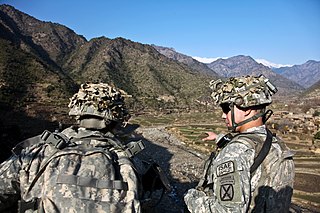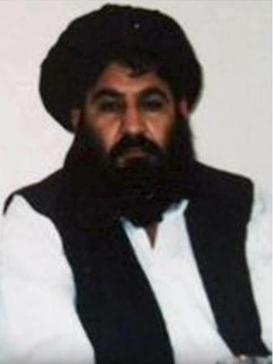
Operation Enduring Freedom (OEF) was the official name used by the U.S. government for both the first stage (2001–2014) of the War in Afghanistan (2001–2021) and the larger-scale Global War on Terrorism. On 7 October 2001, in response to the September 11 attacks, President George W. Bush announced that airstrikes targeting Al-Qaeda and the Taliban had begun in Afghanistan. Beyond the military actions in Afghanistan, Operation Enduring Freedom was also affiliated with counterterrorism operations in other countries, such as OEF-Philippines and OEF-Trans Sahara.

Muhammad Umar, known in the West as Mullah Omar, was an Afghan militant who founded the Taliban in 1994. During the Afghan Civil War of 1996–2001, the Taliban fought the Northern Alliance and took control of most of the country, establishing the First Islamic Emirate for which Omar began to serve as Supreme Leader in 1996. Shortly after al-Qaeda carried out the September 11 attacks, the Taliban government was toppled by an American invasion of Afghanistan, prompting Omar to go into hiding. He successfully evaded capture by the American-led coalition before dying in 2013, reportedly from tuberculosis.
The following lists events that happened during 2001 in Afghanistan.

Shortly after the September 11 attacks, the United States declared the beginning of the war on terror and subsequently led a multinational invasion of Taliban-ruled Afghanistan. The stated goal was to dismantle al-Qaeda, which had executed the attacks under the leadership of Osama bin Laden, and to deny Islamist militants a safe base of operations in Afghanistan by toppling the Taliban government. The United Kingdom was a key ally of the United States, offering support for military action from the start of the invasion preparations. The American military presence in Afghanistan greatly bolstered the Northern Alliance, which had been locked in a losing fight with the Taliban during the Afghan Civil War. Prior to the beginning of the United States' war effort, the Taliban had seized around 85% of Afghanistan's territory as well as the capital city of Kabul, effectively confining the Northern Alliance to Badakhshan Province and smaller surrounding areas. The American-led invasion on October 7, 2001, marked the first phase of what would become the 20-year-long War in Afghanistan and was the technical start of the War on Terror.

The Taliban insurgency began after the group's fall from power during the 2001 War in Afghanistan. The Taliban forces fought against the Afghan government, led by President Hamid Karzai, and later by President Ashraf Ghani, and against a US-led coalition of forces that has included all members of NATO; the 2021 Taliban offensive resulted in the collapse of the government of Ashraf Ghani. The private sector in Pakistan extends financial aid to the Taliban, contributing to their financial sustenance.

The fall of Mazar-i-Sharif in November 2001 resulted from the first major offensive of the Afghanistan War after American intervention. A push into the city of Mazar-i-Sharif in Balkh Province by the United Islamic Front for the Salvation of Afghanistan, combined with U.S. Army Special Forces aerial bombardment, resulted in the withdrawal of Taliban forces who had held the city since 1998. After the fall of outlying villages, and an intensive bombardment, the Taliban and al-Qaeda forces withdrew from the city. Several hundred pro-Taliban fighters were killed. Approximately 500 were captured, and approximately 1,000 reportedly defected. The capture of Mazar-i-Sharif was the first major defeat for the Taliban.

The following items form a partial timeline of the War in Afghanistan. For events prior to October 7, 2001, see 2001 in Afghanistan.
The following lists events that happened during 2004 in Afghanistan.
The Azizabad airstrike was carried out by the United States Air Force on Friday 22 August 2008 in the village of Azizabad which is located in Shindand district, Herat Province, Afghanistan. The airstrike killed 92 civilians, mostly children, and a number of structures in the village including homes were damaged or destroyed, although there remains some dispute about the accuracy of these figures. A Taliban commander was the intended target of the airstrike.
Operation Crescent Wind was the codename for the American and British air campaign over Afghanistan in October and November 2001. The bombing campaign was aided by British special forces troops on the ground to provide targeting information for airstrikes. The campaign significantly weakened the Taliban, paving the way for offensives by the Northern Alliance to take place in November which quickly overran Taliban-controlled regions of Afghanistan.

The Fall of Kandahar took place in 2001 during the War in Afghanistan. After the fall of Mazar-i-Sharif, Kabul and Herat, Kandahar was the last major city under Taliban control. Kandahar was where the Taliban movement had originated and where its power base was located, so it was assumed that capturing Kandahar would be difficult. The city fell after several weeks of fighting to a force of local militia under Pashtun military commanders and their American advisers. The fall of Kandahar signaled the end of organized Taliban control of Afghanistan.
See also: 2007 in Afghanistan, other events of 2008, 2009 in Afghanistan and Timeline of the War in Afghanistan (2001-14).
The following lists events that happened during 2015 in Afghanistan.

Akhtar Mohammad Mansour was the second supreme leader of the Taliban. Succeeding the founding leader, Mullah Omar, he was the supreme leader from July 2015 to May 2016, when he was killed in a US drone strike in Balochistan, Pakistan.
The following lists events that happened during 2016 in Afghanistan.

The Battle of Boz Qandahari occurred on 3 November 2016, in the village of Boz Qandahari, on the western outskirts of the Afghan city of Kunduz, between Afghan National Army Commandos alongside United States Army Special Forces against Taliban insurgents.
Events in the year 2017 in Afghanistan.
Events in the year 2018 in Afghanistan.
This article summarizes the history of the War in Afghanistan (2001–2021).








